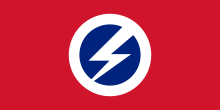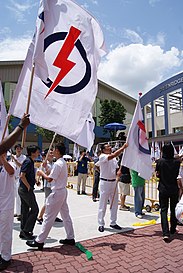Flash and circle
This section contains an unencyclopedic or excessive gallery of images. |

The Flash and Circle is a political symbol used by several organisations. It was first used by the British Union of Fascists (BUF), and was adopted in 1935.[1] The symbol represents action within unity
Origins within the BUF (1935-1940)
From its foundation in 1932, the BUF adopted the fasces as its emblem which embodied the values of the movement with the bundle of sticks representing strength within unity and the axe representing the supreme authority of the state in which everyone owes their allegiance too. Whilst the Fasces was utilised almost extensively by Benito Mussolini's Blackshirts the BUF claimed that they had a right to use the symbol on the basis that the Fasces was used extensively in Britain the times of the Romans and that the British Empire continued to carry on the tradition of civilisation from them.[2] The symbol would officially be changed in March 1934 from the plain gold Fasces to a Union Flag within a shield and a Fasces placed on top. The reasons for this change was that the BUF wanted to emphasise its commitment to King and Country through the addition of the national emblem, the other reason was to help the movement distinguish itself in foreign nations.
Whilst the Fasces would be retained and be used countiluly through the rest of the 1930s, it would go onto be phased out by the BUF's final symbol the Flash and Circle. In the summer of 1935, Eric H. Piercy, the commander of the Fascist Defence Force designed the emblem and presented it to Oswald Mosley the BUF's leader.[1] The official colors were, a white lightning bolt or flash and circle, A blue roundel and a red background. The symbolism of this design was meant to convey a flash of action within a circle of unity. Whilst there was a lack of consistency in the appearance of the Flash and Circle such as the shortly lived inverted version used in 1935, it would go onto become the main symbol of the party and was used extensively throughout 1935-1940.[1] The BUF's left-wing opponents nicknamed the symbol "the flash in the pan".[3] The usage of any symbols by the BUF would slowly decline after the party was banned and its leadership including Mosley was interned on the 23 May 1940 under Defence Regulation 18B.

Post-War Usage (1948 onwards)
After being released from internment, Mosley would continue his political activities creating the Union Movement (UM) in February 1948.[4] The UM would go onto to adopt the Flash and Circle as its symbol. Throughout the 50s and 60s multiple branch flags were adopted using a black background with a yellow Flash and Circle with the name of the branch underneath in yellow as well. Another variant was adopted by the Mosley Youth in the early 50s. This design consisted of a red background with a black circle and a white flash.[5]
Usage outside of the BUF
The emblem of the Bulgarian fascist party, Union of Bulgarian National Legions (SBNL) utilised a variant of the version of flash and circle, replacing the swastika.[6] The lightning bolt represented the SBNL striking at communism.[7] Eventually the emblem would replace the lightning bolt with the swastika towards the end of 1944.

The insignia of Singapore's People's Action Party (PAP) is composed of a red flash struck through a smaller blue circle on a white background. The PAP insignia is claimed to represent "action within social/racial unity" with the white background representing purity in thought and deed.[8]
Similar non-political symbols
The simple combination of the lightning bolt and circle elements appears to have led to many similar designs unrelated to the flash and circle. These include the logo of BoltBus, which chose the design before the similarity was ever noticed.[9] One form of warning sign for high-voltage electricity uses a lightning bolt inside a circle, and this was repurposed by Marilyn Manson as an insignia for his album Antichrist Superstar.[10] In most cases, there is no evidence to suggest that the designer intended to evoke an association with political use of the symbol. German automobile manufacturer, Opel uses flash and circle as company logo.
See also
References
- ^ a b c Millican, John (2020). Mosley's Men in Black. Shelton Street, London: Sanctuary Press Ltd. p. 17. ISBN 978-1-912887-66-8.
- ^ Millican, John (2020). Mosley's Men in Black. Shelton Street, London: Sanctuary Press Ltd. p. 15. ISBN 978-1-912887-66-8.
- ^ Benewick, Robert (1969), Political Violence & Public Order: A Study of British Fascism, p. 139
- ^ Millican, John (2020). Mosley's Men in Black. Shelton Street, London: Sanctuary Press Ltd. p. 137. ISBN 978-1-912887-66-8.
- ^ Millican, John (2020). Mosley's Men in Black. Shelton Street, London: Sanctuary Press Ltd. p. 139. ISBN 978-1-912887-66-8.
- ^ Дечев, Теодор (2020-03-04). "Една панихида е по-човешка от факелно шествие". News.bg (in Bulgarian). Retrieved 2020-11-03.
- ^ ""НС Трибуна" - Съюз на Българските Национални легиони (СБНЛ)". nstribuna.org. Retrieved 2020-11-03.
- ^ Drysdale, John (1984), Singapore: Struggle for Success, p. 80
- ^ Hopper, Tristin (January 28, 2016). "Fascist, schmaschist: Why a West Coast bus company picked the same logo as some dead British fascists". The National Post. Retrieved January 13, 2020.
- ^ Baddeley, Gavin (2001). Dissecting Marilyn Manson. London: Plexus Publishing. pp. 101–102. ISBN 0859653722 – via GoogleBooks.
The insignia that represents the Antichrist Superstar album ... also echoes the insignia of Oswald Moseley's British Union of Fascists...
